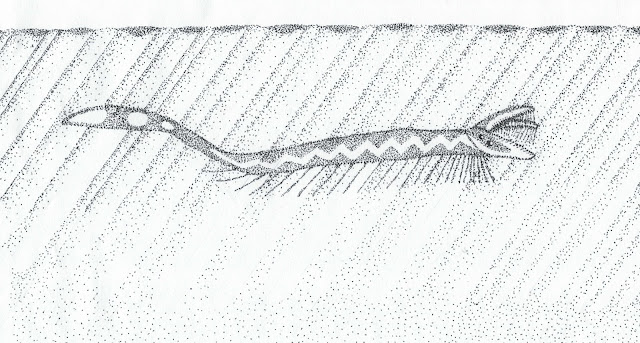I lied earlier, when I said that one of the major Martian phyla are the Brachiostoma. This is because, technically, there is no such thing as Brachiostoma. It is a waste-basket-taxon for all vaguely worm-like lifeforms found so far on Mars and much of our recent work indicates that it needs to be broken up into multiple distinct phyla. Some, such as the subglacial tentacle-worm, which gave the group its name, are radially symmetrical and possess tendrils around the mouth, making them very similar to Mollizoa and perhaps Trichordata, whereas others seem to be more closely related to bilaterally symmetrical phyla, such as Onychognatha and Spiriferia.
Then there are ones which are something else onto themselves. The Cavesea Hekubus seen here is a member of the Diplognatha, a class inside the wider phylum Circulata. Circulates generally resemble annelids, in that they have a limbless, segmented body supported by a hydroskeleton consisting of multiple rings. The majority of Circulata consists of entirely soft-bodied animals, but Diplognatha stand out for having a single, endoskeletal hard part: A skull and jaw made of calcite. The configuration of this head is rather unusual, by Earth-standards. The inflexible and bow-shaped cranium is what also forms the lower jaw, while the upper jaw is split into two mandibles which can be moved independently from each other. In some forms the mandibles bear teeth used for predation, in others they have setae to filter-feed. Setae can also be found along the body of many species, where they aid in swimming.
The Hekubus is a rather harmless and small filter-feeder, fitting into a human hand. Using its setae, it filters the flooded caverns of many Martian cave systems for smaller lifeforms and food particles. During the long winters, where even in the caves most primary producers lie dormant, it buries itself into cavities and hibernates. During this phase, where most of its environment becomes anoxic, it survives through its secondary methanogenic metabolism.
Unusual for a troglodyte, the Hekubus still has eyes, four of them to be exact. This is because many aquatic cave dwellers on Mars are capable of bioluminescence. The Hekubus uses colorful markings on its body and tail fluke to attract smaller planktonic organisms, like a lamp does with moths. These markings are also used to communicate with other worms, mainly to attract mates. Larger, predatory cave dwellers, such as neckfisk, have apparently learned to exploit this and attract unwary hekubi by mimicking their mating-lights.
The Hekubus reproduces in a basic manner by laying simple eggs that are externally fertilized. Since they are hermaphrodites, it is interesting that during spawning, the mates can apparently coordinate who releases the eggs and who the sperm. In Martian animals which practice internal fertilization, this is usually determined through fights, but hekubi do apparently not resort to such behaviour, making it mysterious how they do it. Like in most arezoans, if a suitable mate cannot be found, hekubi can also practice self-fertilization. This reduces genetic diversity for the next generation, but is helpful to straddle times of low population density.



No comments:
Post a Comment